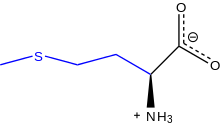Type: Essential Amino Acid
Name: Methionine (Met, L-methionine, M)
RDA: ~ 2g-3g
Importance – to body:
Used to assist mood disorders (depression), schizophrenia, alcoholism, allergies, copper poisoning, Parkinson’s disease, asthma, drug withdrawal, radiation side effects, and allergies. Methionine contains Sulphur and the cartilage in the body’s joints require Sulphur (the lack of Sulphur can lead to arthritis as well as a delay in the healing process). Methionine helps to strengthen nails and fight hair loss, helps in detoxification (can help reduce the buildup of toxins and free radicals in the body). Methionine is one of two Sulphur containing essential amino acids!
Distribution – in body:
Plays a crucial role in the body’s metabolism, is a protein-building essential amino acid, plays a big rule in angiogenesis (the growth of new blood vessel, and has a fat-dissolving effect and reduces the depositing of fat in the liver. The kidneys can use methionine to acidify urine, methionine is used for acetaminophen poisoning, there is less of a chance for a pregnant woman to face neural tube birth defects when consuming a healthy amount of methionine, but it must be discussed with a health provider prior for the safety of the fetus. Methionine also protects the tissues in the body and maintains proper cell function.
Excess effects:
Cancer growths, Nnausea, Vomiting, Brain Damage, Tumors, possibly Death.
Deficiency effects:
Elevated Cholesterol, Liver Damage, Poor or Dull Skin Tone, Muscle Weakness, Hair Loss, Weak/Brittle Nails.
Food Sources:
Protein-rich foods (Eggs, Poultry, Fish, Chicken, Pork, Liver, Beef, Nuts), some Dairy products (Brazil nuts are especially high in methionine), Pumpkin and Sunflower Seeds.
Environmental/Geographic Sources:
Supplemental information:
Studies have shown that a healthy individual’s cartilage has 3 times more Sulphur than an individual with arthritis/ Body builders often use L-methionine supplements to aid in protein synthesis and build up the muscles that need repairing in the body. Methionine has not been proven to treat or prevent any illnesses or diseases. More research is needed to prove any attention.
 Canonical form of methionine
|
|
 Resonance line-angle diagram of L-methionine at physiological pH
|
|
| Names | |
|---|---|
| IUPAC name
Methionine
|
|
| Other names
2-amino-4-(methylthio)butanoic acid
|
|
| Identifiers | |
|
3D model (JSmol)
|
|
| Abbreviations | Met, M |
| ChEBI | |
| ChEMBL | |
| ChemSpider | |
| ECHA InfoCard | 100.000.393 |
| EC Number | 200-432-1 |
| KEGG | |
|
PubChem CID
|
|
| UNII | |
|
|
|
|
| Properties | |
| C5H11NO2S | |
| Molar mass | 149.21 g·mol−1 |
| Appearance | White crystalline powder |
| Density | 1.340 g/cm3 |
| Melting point | 281 °C (538 °F; 554 K) decomposes |
| Soluble | |
| Acidity (pKa) | 2.28 (carboxyl), 9.21 (amino) |
| Pharmacology | |
| V03AB26 (WHO) QA05BA90 (WHO), QG04BA90 (WHO) | |
| Supplementary data page | |
| Refractive index (n), Dielectric constant (εr), etc. |
|
|
Thermodynamic
data |
Phase behaviour solid–liquid–gas |
| UV, IR, NMR, MS | |
|
Except where otherwise noted, data are given for materials in their standard state (at 25 °C [77 °F], 100 kPa).
|
|
| Infobox references | |
Methionine (symbol Met or M) (/mɪˈθaɪəniːn/) is an essential amino acid in humans. As the substrate for other amino acids such as cysteine and taurine, versatile compounds such as SAM-e, and the important antioxidant glutathione, methionine plays a critical role in the metabolism and health of many species, including humans. It is encoded by the codon AUG.
Methionine is also an important part of angiogenesis, the growth of new blood vessels. Supplementation may benefit those suffering from copper poisoning. Overconsumption of methionine, the methyl group donor in DNA methylation, is related to cancer growth in a number of studies. Methionine was first isolated in 1921 by John Howard Mueller.

